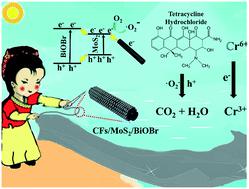当前位置:
X-MOL 学术
›
Environ. Sci.: Nano
›
论文详情
Our official English website, www.x-mol.net, welcomes your
feedback! (Note: you will need to create a separate account there.)
Fabrication of MoS2/BiOBr heterojunctions on carbon fibers as a weaveable photocatalyst for tetracycline hydrochloride degradation and Cr(VI) reduction under visible light
Environmental Science: Nano ( IF 5.8 ) Pub Date : 2020-07-13 , DOI: 10.1039/d0en00551g Zhun Shi 1, 2, 3, 4, 5 , Yan Zhang 5, 6, 7, 8 , Gumila Duoerkun 5, 6, 7, 8 , Wei Cao 5, 6, 7, 8 , Ting Liu 5, 6, 7, 8 , Lisha Zhang 5, 6, 7, 8 , Jianshe Liu 5, 6, 7, 8 , Maoquan Li 1, 2, 3, 4, 5 , Zhigang Chen 1, 2, 3, 4, 5
Environmental Science: Nano ( IF 5.8 ) Pub Date : 2020-07-13 , DOI: 10.1039/d0en00551g Zhun Shi 1, 2, 3, 4, 5 , Yan Zhang 5, 6, 7, 8 , Gumila Duoerkun 5, 6, 7, 8 , Wei Cao 5, 6, 7, 8 , Ting Liu 5, 6, 7, 8 , Lisha Zhang 5, 6, 7, 8 , Jianshe Liu 5, 6, 7, 8 , Maoquan Li 1, 2, 3, 4, 5 , Zhigang Chen 1, 2, 3, 4, 5
Affiliation

|
The photocatalytic removal of organic pollutants and heavy metals in water has become a hot topic, and its prerequisite is to obtain efficient and recyclable visible-light-driven (VLD) photocatalysts. To solve this issue, we constructed MoS2/BiOBr heterojunctions on carbon fibers (CFs) as a flexible and weaveable VLD photocatalyst. Firstly, MoS2 nanosheets (thickness: ∼5 nm, diameter: 200–400 nm) were anchored on CFs. Subsequently, a layer of BiOBr lamellae (thickness: ∼25 nm, diameter: 300–600 nm) was grown. CFs/MoS2/BiOBr bundles were weaved into cloth, and the cloth could photocatalytically eliminate 92.4% tetracycline hydrochloride (TCH) or 90.7% hexavalent chromium (Cr6+) in 120 min, higher than CFs/MoS2 cloth (43.2%/43.6%) and CFs/BiOBr cloth (51.8%/33.5%). Photogenerated holes and superoxide radicals were found to be the main active species. In particular, a possible photodegradation pathway of TCH was proposed according to the intermediates. Thus, CFs/MoS2/BiOBr can act as a weaveable and recyclable photocatalyst for potential applications in treating wastewater.
中文翻译:

在碳纤维上制备MoS2 / BiOBr异质结作为可编织的光催化剂,用于可见光下盐酸四环素的降解和Cr(VI)的还原
光催化去除水中的有机污染物和重金属已成为热门话题,其前提是要获得高效且可回收的可见光驱动(VLD)光催化剂。为解决此问题,我们在碳纤维(CFs)上构建了MoS 2 / BiOBr异质结,作为一种可编织的VLD光催化剂。首先,将MoS 2纳米片(厚度:〜5 nm,直径:200-400 nm)固定在CF上。随后,生长了一层BiOBr薄片(厚度:〜25 nm,直径:300-600 nm)。将CFs / MoS 2 / BiOBr束编织成布,布在120分钟内可光催化去除92.4%的四环素盐酸盐(TCH)或90.7%的六价铬(Cr 6+),高于CFs / MoS 2布(43.2%/ 43.6%)和CFs / BiOBr布(51.8%/ 33.5%)。发现光生空穴和超氧自由基是主要的活性物种。特别地,根据中间体提出了可能的TCH光降解途径。因此,CFs / MoS 2 / BiOBr可以作为可编织和可回收的光催化剂,用于废水的潜在应用。
更新日期:2020-09-18
中文翻译:

在碳纤维上制备MoS2 / BiOBr异质结作为可编织的光催化剂,用于可见光下盐酸四环素的降解和Cr(VI)的还原
光催化去除水中的有机污染物和重金属已成为热门话题,其前提是要获得高效且可回收的可见光驱动(VLD)光催化剂。为解决此问题,我们在碳纤维(CFs)上构建了MoS 2 / BiOBr异质结,作为一种可编织的VLD光催化剂。首先,将MoS 2纳米片(厚度:〜5 nm,直径:200-400 nm)固定在CF上。随后,生长了一层BiOBr薄片(厚度:〜25 nm,直径:300-600 nm)。将CFs / MoS 2 / BiOBr束编织成布,布在120分钟内可光催化去除92.4%的四环素盐酸盐(TCH)或90.7%的六价铬(Cr 6+),高于CFs / MoS 2布(43.2%/ 43.6%)和CFs / BiOBr布(51.8%/ 33.5%)。发现光生空穴和超氧自由基是主要的活性物种。特别地,根据中间体提出了可能的TCH光降解途径。因此,CFs / MoS 2 / BiOBr可以作为可编织和可回收的光催化剂,用于废水的潜在应用。










































 京公网安备 11010802027423号
京公网安备 11010802027423号